#159: Dyeing with Mushrooms
Natural dyes come from many sources: plants, animals, and even fungi. Historically, lichens were used to achieve certain colors, including purples and reds. Techniques for lichen dying have been around for thousands of years. Surprisingly, using mushrooms to dye fibers was first developed in 1972! The procedure for mushroom dyeing was developed by Miriam C. Rice, who I have previously mentioned as the inventor of mushroom papermaking (FFF#084). The procedure for mushroom dyeing is pretty much the same as when using other natural dyes: treat the fibers with a mordant, cook the fibers with the dye, and rinse the fibers.i
History
Miriam C. Rice was undoubtedly the most successful person in the field of mushroom arts ever. Nearly every artistic use for mushrooms can be traced back to work she did in the late 20th century. She was introduced to mushrooms as an artistic tool in 1968, when her mushroom hunting friends invited her on a foray. Already an accomplished artist with an interest in natural dyes, Rice immediately saw the dyeing potential of mushrooms. After a few years of experimentation, she published her first book on the subject of mushroom dyes, Let’s Try Mushrooms for Color in 1974.ii
Rice went on to experiment with other artistic uses for mushrooms and invented various ways of condensing mushroom pigments and the process for producing paper from mushrooms. With the help of colleagues interested in mushroom arts, she established the International Mushroom Dye Institute and helped put together the first International Fungi & Fibre Symposium. Rice passed away in 2010, but interest in the artistic uses of fungi has steadily grown (especially in Sweden) thanks to her work.iii
This year, the 17th International Fungi & Fibre Symposium will be held in Madeira Park, British Columbia, Canada from October 17 to 22. As a testament to the growing popularity of this mycological subculture, registration for this event has sold out and there is a wait list.iv This is truly an international event, since previous symposia have been held in various European countries, the United States, and even Australia.v
Ingredients
Before attempting to use mushrooms for dyeing, it is important to have the right materials. Below is a list of common materials used in mushroom dyeing:vi
- Fiber: Protein fibers work best for mushroom dyeing, although cellulose fibers can be used as well. The mushroom dyeing community has focused on wool, so most of the available information is catered to wool dyeing. Other protein fibers that work well include: silk, alpaca, angora, and cashmere. Silk, however, requires greater attention and a higher mushroom to fiber ratio. Cellulose fibers, which include cotton and linen, will take mushroom dyes but result in more muted colors.
- Mushrooms: If you want to produce certain colors, then having the right mushrooms is important. Many mushrooms are “dye duds,” including most brightly-colored species (for example, Russula species are terrible dyers). Thankfully, the amazing diversity of mushrooms means that you can produce almost any color imaginable. The Dyer’s Polypore (Phaeolus schweinitzii) produces oranges, yellows, and greens. The Cortinarius sanguineus group imparts wool with brilliant reds, oranges, and yellows. Hapalopilus nidulans is a small, unassuming polypore that dyes wool amazing shades of purple. Blue colors can be obtained from a variety of Hydnellum species, although these are often tricky to work with. If you want to find a mushroom that will give you a specific color, you should buy one of Rice’s books or sign up for a mushroom dyeing workshop. Of course, if you’re just experimenting, you can try any mushroom you can find! This art is still relatively new, so you never know what you may discover! See this site for a partial list of mushrooms and the colors they impart.
- Pots: Stainless steel or enamel pots are best for dyeing, since they will not react with the colors or mordants. Aluminum, iron, and copper pots can assist the dyeing process when working with alum, iron salt, and copper mordants, respectively. Make sure your pots can hold both the dye bath and yarn. Also, don’t use pots that you normally use for cooking.
- Thermometer: Dyeing works best when the temperature is kept at an optimal range, so a good cooking thermometer will be a big help.
- pH Paper: Some dyes work best at an optimum pH, so you may need pH paper to adjust the pH properly.
- Cheesecloth: Used to separate out the mushrooms before adding the wool. This way, you won’t have to pick pieces of mushrooms out of the wool after you finish.
- Distilled water: Tap water contains impurities that can interfere with the mordants you use, so distilled water works best.
- Mordants: Such as alum and iron salts (cream of tartar is used along with both of these)
- pH Modifiers: Such as vinegar and ammonia
- Soap: Gentile soap should be used to wash the wool beforehand; Ivory Snow™ is a favorite among wool dyers.
- Environment: Because of the chemicals involved, you should always work in a well-ventilated area.
- Other items: Tongs/chopsticks to manipulate fibers in hot water, rubber gloves/potholders, towels, timer, measuring cups/spoons, other containers, labels
Preparing Fiber
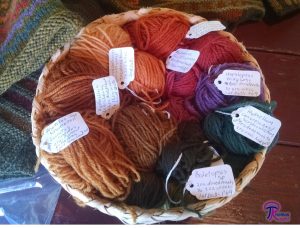
Different mordants and mushrooms can create a wide variety of colors.
The first preparation step is to divide the yarn into manageable loops. Loops of about two feet in length seem to work the best. This ensures the yarn is loose enough to allow it to dye evenly and doesn’t become too tangled. Tie the yarn in four places around the loop to help prevent the yarn from becoming tangled.vii
If you’re using wool, it should be washed beforehand to remove any oils from the animals or wool preparation process. These may interfere with the wool’s ability to hold a dye, so it is important to remove them. To “scour” the wool, soak it in hot water with a mild detergent for half an hour. Then, remove the wool and gently squeeze it without rubbing or twisting it. Too much agitation can result in felting. Next, immerse the wool in hot water. Repeat the scouring process until the water from the wool runs clear. Other fibers should also be cleaned, but the process may vary.viii
Before the yarn can be dyed, it must be treated with a mordant. Yarn can be died without a mordant, but the colors will not be as bright and will fade easily. Two common mordants are alum and iron (ferrous sulfate). Copper sulfate is sometimes used, but this chemical is toxic to aquatic life must be disposed of properly.ix As a general rule, alum makes colors brighter while iron makes colors more muted. P. schweinitzii, for example, dyes golden yellow with alum and dark forest green with iron.x
Generally, you soak the yarn in warm water overnight, dissolve the mordant and add it to the yarn bath, heat the wool to about 175°F for about an hour, let the solution cool, remove the yarn, gently squeeze out the water, rinse out the yarn, and let the wool dry. Make sure to do this in a ventilated area while wearing rubber gloves to minimize the risk of injury. See the NAMA page on dyeing for proper mordanting amounts and procedures.xi
If you are testing the dying ability of a new mushroom, you can make a small bundle of tester pieces. Tie together three short pieces of yarn: one with no mordant, one treated with alum, and one treated with iron. This allows you to make up a small batch of dye bath and quickly test the dyeing ability of a new mushroom.xii
To differentiate yarn by its mordant, Rice developed a knot system: 0 knots for no mordant, 1 knot for alum, and 5 knots for iron. Potassium dichromate, stannous chloride and copper sulphate were represented by 2, 3, and 4 knots, respectively, but these are generally considered too toxic for normal use. Potassium dichromate is particularly dangerous because it can disrupt cell function and is a severe health hazard.xiii
Dyeing Fiber
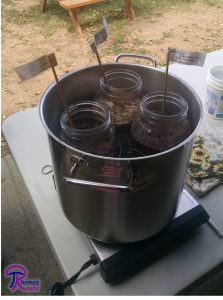
Wool heating in three different mushroom dye baths.
After choosing a mushroom (or multiple mushrooms to experiment with combining colors), you should dry it out and break it into small pieces, the smaller the better. For most mushrooms, you use a 1:1 weight ratio of yarn to dried mushrooms. Certain fibers require more mushrooms per weight and you can use fewer mushrooms if they are ones that dye very strongly (such as C. sanguineus or H. nidulans). Soak the mushrooms in water overnight, then heat them to about 175°F for an hour. While cooking the mushrooms, adjust the pH if needed. The polypores and toothed fungi need to have their pH adjusted to 9. This is done by adding a base to the solution. Most people use ammonia and add about a tablespoon at a time. To adjust the pH correctly, check using pH paper after each addition of ammonia. If you make the bath too basic, add a little bit of vinegar or another acid to lower the pH. Let the mushroom bath cool and then strain it through the cheesecloth to catch the tiny bits of mushroom. Squeeze as much water as possible out of the mushrooms, then tie up the mushroom-containing cheesecloth and return it to the dye bath.xiv
Next, add the dry, pre-mordanted wool to the dye bath. Make sure there is enough water in the bath to allow the yarn to move freely. If you are using a mushroom that needs pH adjustment, make sure the pH is still correct after the yarn and water are added. Bring the temperature of the dye bath up to about 175°F or keep it below 170°F if using silk or toothed mushrooms. Use tongs or chopsticks to adjust the yarn a few times while dying it. You can also check the wool’s color throughout this process. If the yarn arrives at a desirable color before the hour is up, you can remove it from the dye bath and place it in a pot of water heated to the same temperature as the dye bath. After dyeing the yarn, remove the dye bath from the heat and let it cool slowly to room temperature (overnight, if possible). Next, remove the yarn and gently squeeze any excess water back into the dye bath. Gently rinse the yarn in room temperature water and pick out any mushroom pieces that may have gotten tangled up in the wool. Finally, let the yarn air dry out of direct sunlight.xv
The dye bath can be reused to dye more batches of yarn. This usually results in a lighter color than the previous bath, but the stronger dyers can still produce striking colors after several uses. When using some mushrooms, different colors may come out when the dye bath is reused. For example, the C. sanguineus group using alum mordant starts off bright red but produces a deep orange on the second bath, a golden yellow on the third bath, and lighter shades of yellow during further batches.xvi
Keeping Records
Using mushrooms to dye fibers is more of an art than a science. If you are planning on doing a lot of fiber dyeing in the future, it would be very helpful to keep records of your past experiments. To achieve consistent results, you need to make a note of the species of mushroom, type of yarn, yarn weight, mordant, yarn to mushroom weight ratio, time and temperature spent in the dye bath, pH and modifier (if modified), and the number of times the dye bath has been used. Many people also find it useful to keep a sample of the dyed wool along with this record to make picking colors easy in the future.xvii
See Further:
http://www.namyco.org/fiber_dye_mushrooms.php
http://www.mushroomsforcolor.com/HISTORY.htm
http://sonic.net/~dbeebee/IMDI_new/mordants.html
https://blog.mycology.cornell.edu/2006/12/12/dyeing-with-lichens-mushrooms/
Citations
[i] “Dyeing with Lichens & Mushrooms,” Cornell Mushroom Blog, December 12, 2006, https://blog.mycology.cornell.edu/2006/12/12/dyeing-with-lichens-mushrooms/; Dorothy M. Beebee, “A Brief History of the Art of Mushroom Dyeing,” Mushrooms for Color, January 30, 2013, http://www.mushroomsforcolor.com/HISTORY.htm; Cheryl Dawson, “Dyeing Protein Fibers with Mushrooms,” North American Mycological Association, January 2015, http://www.namyco.org/fiber_dye_mushrooms.php.
[ii] Beebee, “A Brief History of the Art of Mushroom Dyeing.”
[iii] Ibid.
[iv] “17th International Fungi & Fibre Symposium,” fungiandfibre2016, accessed September 22, 2016, https://fungiandfibre2016.org/.
[v] Dorothy Beebee, “Mushrooms for Color | Symposia,” Mushrooms for Color, September 9, 2016, http://www.mushroomsforcolor.com/SYMPOSIA.htm.
[vi] Dawson, “Dyeing Protein Fibers with Mushrooms.”
[vii] Ibid.
[viii] Ibid.
[ix] Ibid.
[x] Susan Hopkins, “NAMA Mushroom Dyeing Workshop Sept. 8, 2016” (NAMA Shenandoah Foray, NoVa 4-H Center, September 8, 2016).
[xi] Dawson, “Dyeing Protein Fibers with Mushrooms.”
[xii] Susan Hopkins, “NAMA Mushroom Dyeing Workshop Sept. 8, 2016.”
[xiii] Dorothy Beebee, Dr. Erik Sundström, and Darvin DeShazer, “About Mordants,” The International Mushroom Dye Institute, 2004, http://sonic.net/~dbeebee/IMDI_new/mordants.html.
[xiv] Dawson, “Dyeing Protein Fibers with Mushrooms.”
[xv] Ibid.
[xvi] Susan Hopkins, “NAMA Mushroom Dyeing Workshop Sept. 8, 2016.”
[xvii] Dawson, “Dyeing Protein Fibers with Mushrooms.”

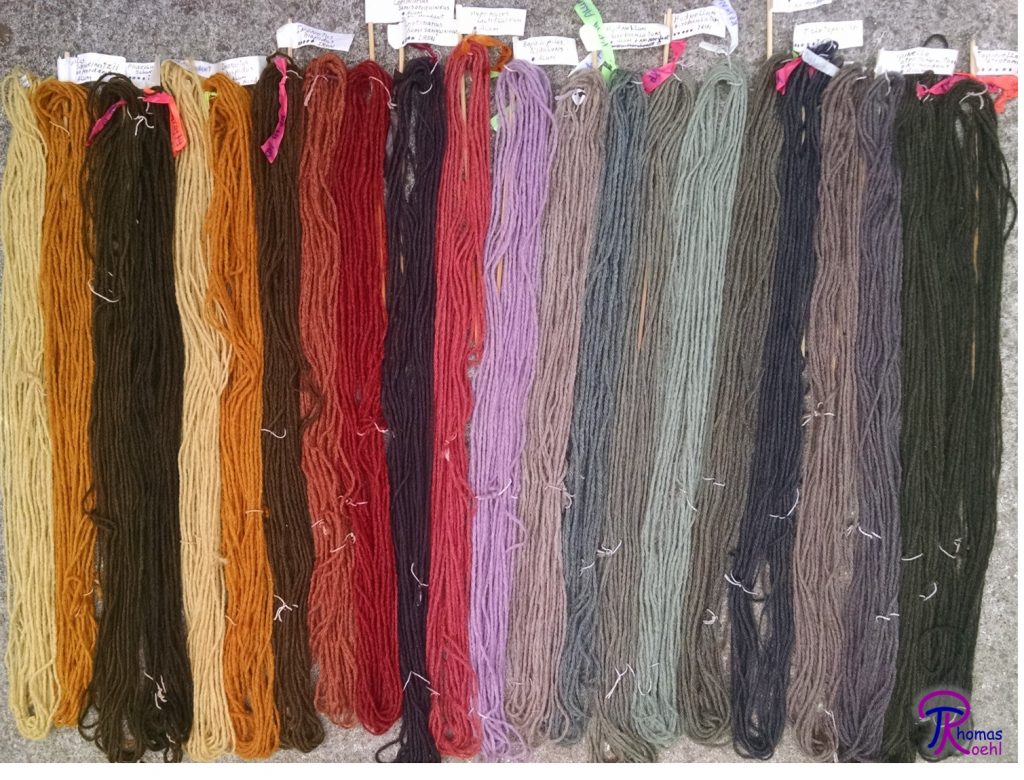
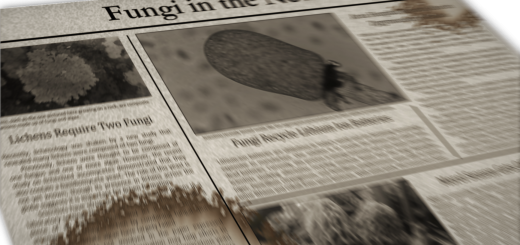

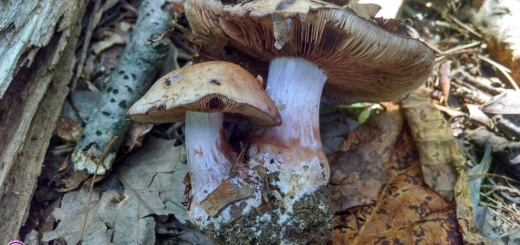





![#011: Characteristics of Kingdom Fungi [Archived]](https://www.fungusfactfriday.com/wp-content/themes/hueman/assets/front/img/thumb-small-empty.png)

5 Responses
[…] and you can probably use less. This is good, since H. nidulans is a fairly uncommon mushroom.7 See FFF#159 for more on dyeing with […]
[…] people interested in dyeing with mushrooms (FFF#159) should brush up on their webcap identification skills. Mushrooms like C. semisanguineus and its […]
[…] the Ash Tree Bolete is useful for more than just food; it can also be used to dye wool (see FFF#159). B. merulioides mushrooms will produce brown and orange colors, depending on the mordant used. It […]
[…] but it does have another use: this mushroom is one of the best to use for dyeing wool (see FFF#159).1,9 The Dyer’s Polypore produces strong colors ranging from golden-yellow to forest green, […]
[…] Dyeing with Mushrooms https://www.fungusfactfriday.com/159-dyeing-with-mushrooms/ […]